

Site Search
Search within product
No. 722 Published 2020 (R02) .07
Click here for PDF version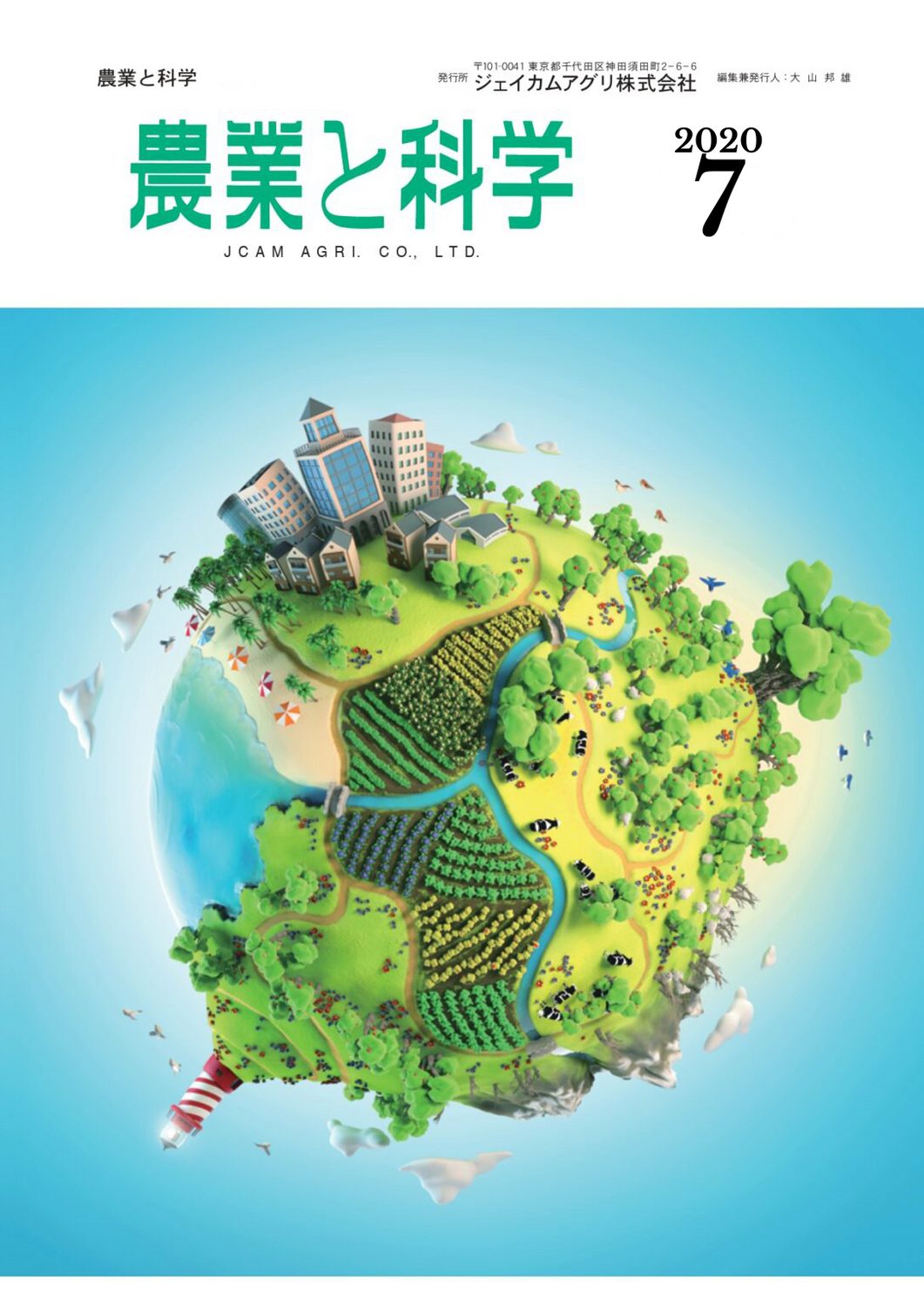
Agriculture and Science 2020/7


Fertilizers and nutrients:
Coated phosphorus ammonium nitrate (long, high control, Nutricote)
Characteristics of (Part 3)
Shibata Professional Engineers Office
Masaru Shibata
(10) Fertilization methods using long
Long's new fertilizer design manuals have been devised and disseminated nationwide through fertilizer efficacy tests and extension trials tailored to the growing conditions in each prefecture for many crops. In fruit and vegetable crops, where nutritional and reproductive growth occur simultaneously, fertilizer application is an important technology for achieving high quality and high yield, because it is necessary to determine the timing and amount of nutrient fertilizer application by watching the fruit development process.
Based on the excellent nutrient supply performance of Long, a system of fertilizer application with emphasis on the primary fertilizer has been developed to simplify the fertilizer application technique. The examples of fertilization designs shown in Table 7 are based on the application of Long as the base fertilizer, with an appropriate amount of additional fertilizer applied according to the growth conditions of the crop. While the total basal application system is widely used for paddy rice, most of the fruit and vegetable crops, which require a longer growing period, have a basal application plus additional fertilizer system, in which fertilizer is applied while watching the crop's face.
The longs used in the fertilizer design are diverse, with the brand and type selected in accordance with the local fertilizer application system. There is also a shift to a total source fertilization method using longs and a progressive fertilization method in which longs are used for additional fertilizer.
Although a lot of test data has already been accumulated for long and high control, the "Long and High Control Test Data Collection," which consolidates the test results published since 2009 in the categories of "Fruits and Vegetables," "Leaf and Stem Vegetables," "Root Crops," "Fruit Trees," "Flowers and Trees," "Craft Crops," and "Forestry and Containerized Seedlings," has been compiled by JCAM Agri Co. The data is compiled by JCAM Agri Co. According to the data, root zone fertilization methods for various crops in the horticultural field have recently been studied, and long-high control has been taken up.
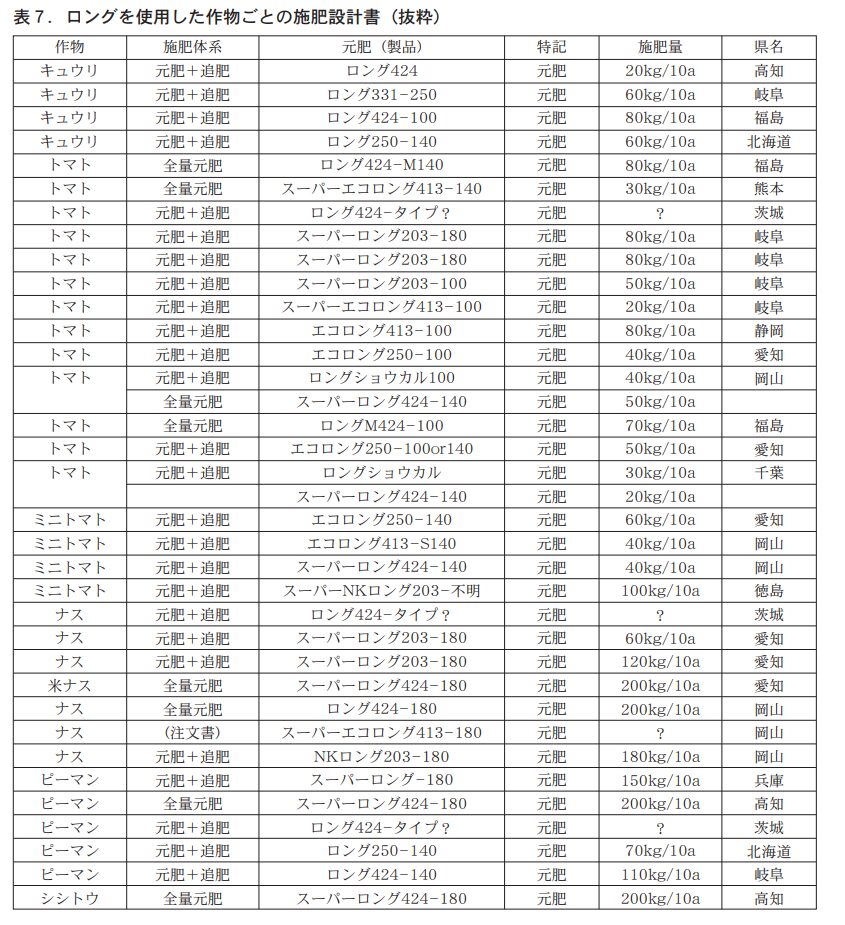
(11) Case study of a root zone fertilization method using long
(1) Long cultivation of healthy paddy rice seedlings
The "field nursery" method, which is superior in rooting ability, has been used in paddy rice seedling cultivation methods. In cold regions, it is known that seedling vigor after transplanting affects seedling yield, and a new method was developed to grow seedlings with 50 to 100 g of Long 424-100 fertilizer applied to the seedling boxes in order to grow seedlings with rooting vigor equivalent to that of "field seedlings" in the easy-to-manage "water seedlings" method. Seedlings grown with this method have high rooting power, grow well after planting, and produce higher yields than conventional seedlings, and the method has been widely used from Tohoku to Hokkaido (Figure 8).
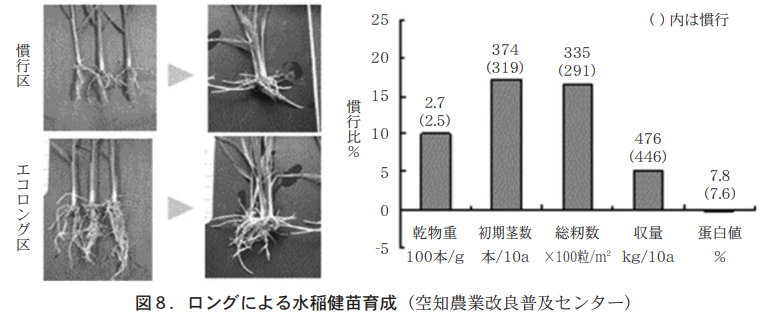
(2) Local fertilization of fruit and vegetable crops
Even in horticultural crops, where full-layer fertilization has been the mainstay, local application methods have been demonstrated with the advent of coated fertilizers.
(1) Tomato: Total in-pot fertilization method (Soil Fertilizer Department, Shizuoka Prefectural Agricultural Experiment Station)
When tomato seedlings are potted into No. 4 pots, Superlong 424-140 is added along with medium to grow tomato seedlings, and when the seedlings have grown, they are removed from the pots and transplanted into the main field. (The amount of nitrogen fertilizer applied was reduced from 20 kg to 16 kg/10 a.) The yield was higher than that of the conventional method. This is a practical fertilization method that outperforms conventional methods in terms of yield (Fig. 9, Tables 8 and 9).
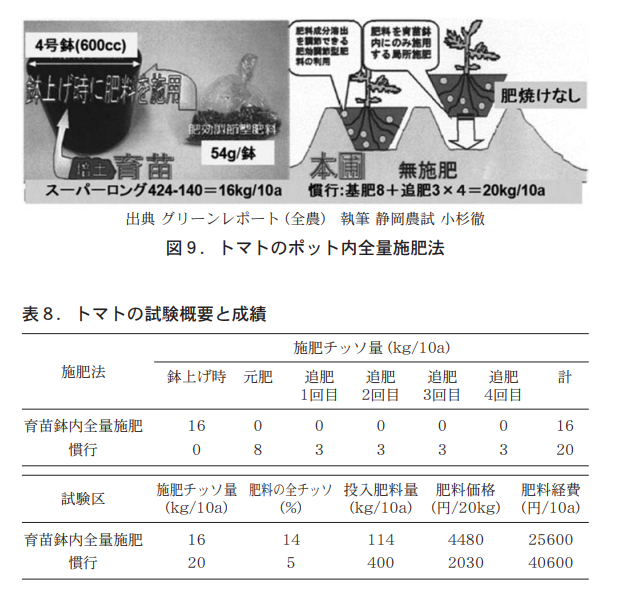
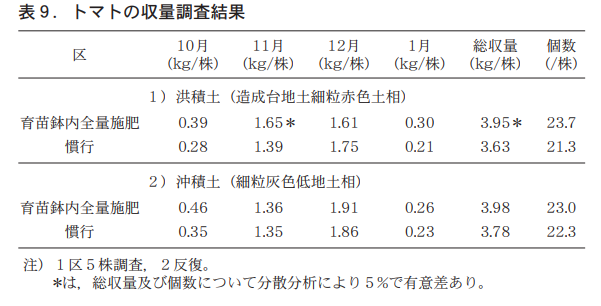
The total in-pot fertilization method frees the farmer from fertilizer application work, allowing him to concentrate on other tasks such as harvesting and picking, and thus enables the farmer to expand the scale of his business. Since fertilizer application is not required in the main field, it is no problem to make ridges long before planting, allowing for the dispersal of field preparation work. In order to popularize this method of fertilization, it is necessary to support the development of inexpensive metering equipment that applies a fixed amount of long fertilizer in pots.
(Reference) What is planting hole fertilization (Photo 4)
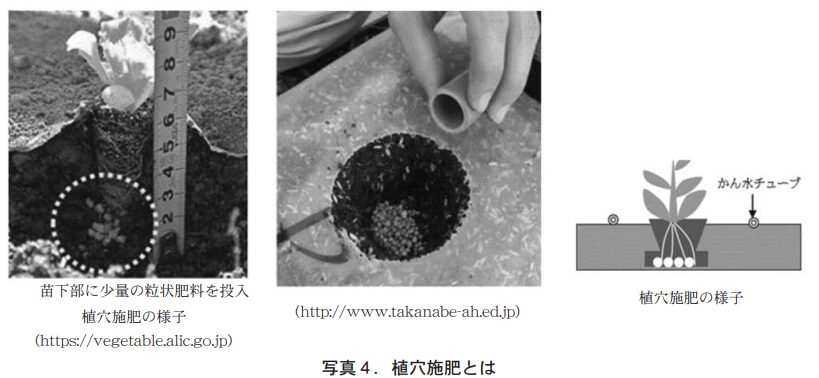
This is literally a fertilizer application method in which holes are drilled with a drilling machine in the area where the seedlings are to be planted, and the required amount of fertilizer is dropped into the holes and mixed with the soil before the seedlings are planted. Since the new roots that develop after planting come into direct contact with the fertilizer, long fertilizers containing nitrate-form chisso are used. In addition, this study was also conducted to develop an accessory equipment for transplanters that transplant lettuce seedlings and apply a fixed amount of fertilizer in the planting hole. Reduction of planting labor is a particularly important issue for agricultural corporations with large planted areas of leafy greens, and the development of machinery that simultaneously performs planting and fertilizer application at the time of transplanting seedlings is expected to advance. For vegetables with high planting densities that are generally covered with mulch, the Long will be used in a wider range of applications, including reducing the labor required for fertilizer application.
Cucumbers: Total basal fertilizer in planting hole at planting time (Nagano Prefectural Nanshin Agricultural Experiment Station)
A new fertilizer application technique has been developed for cucumber cultivation in the open field using ECOLONG in the planting hole, which enables reduction of fertilizer and labor-saving fertilizer addition. 100-type ECOLONG alone or 140-type ECOLONG combined with 30% of 100-type has been used for planting in late May and harvest in late September. With this fertilizer application method, a 30% reduction in fertilizer was achieved compared to the conventional method, and the same crop yield was obtained.
The fertilizer cost can be reduced by eliminating the need for fertilizer application (Table 10). In addition, the elimination of additional fertilizer application is highly labor-effective, and fertilizer costs can be reduced (Table 10).
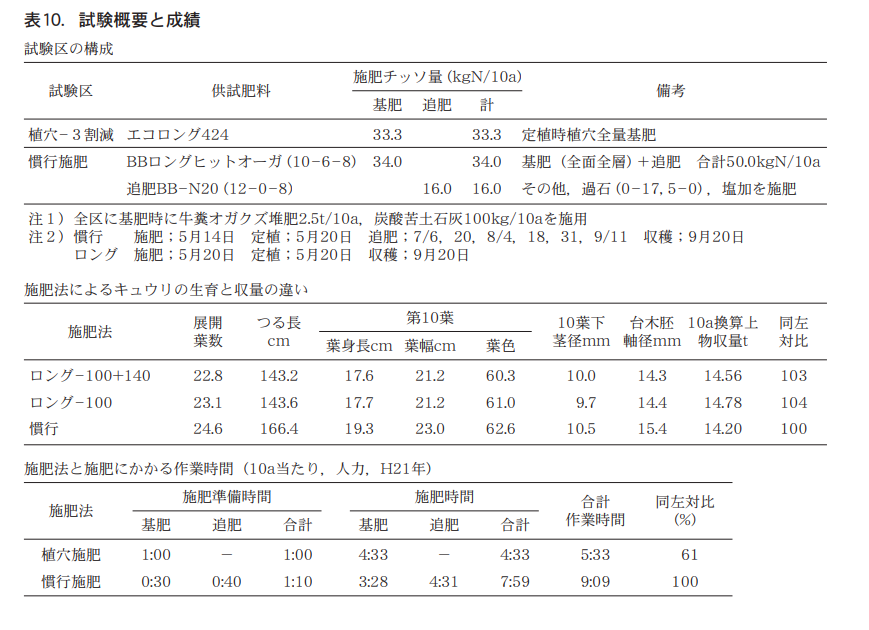
(3) Cellulose: Total basal fertilizer in planting hole at planting time (Shizuoka Prefectural Agricultural and Forestry Experiment Station)
Cellery is a vegetable with a long growing season and high levels of nitrogen fertilizer. In order to increase the utilization rate of applied tisso and reduce the amount of fertilizer without decreasing yield, it is effective to apply fertilizer using a fertilizer with controlled fertilizer effect. In addition to the use of a coated fertilizer (Long 424-70) in celluloid cultivation, simultaneous transplanting using a transplanter was studied (Fig. 10).
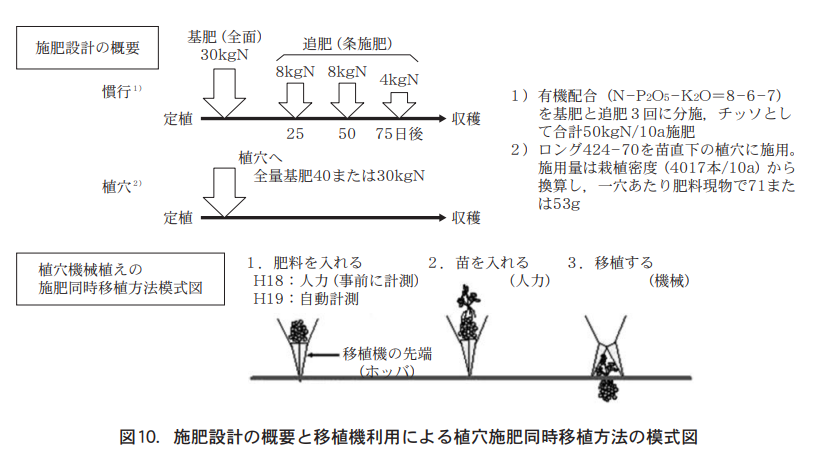
The cultivation method in which the amount of nitrogen fertilizer applied to the planting hole is reduced from 50 kg to 40 kg/10 a and long fertilizer is applied, and celluloid seedlings are planted, also produces yields equivalent to the conventional fertilizer application method. Simultaneous transplanting using a transplanter with hole fertilizer application enables a reduction in labor time to about 1/3 of that required for conventional cultivation, thus saving labor as well as reducing fertilizer (Table 11). The use of mechanical transplanters for planting large numbers of leafy vegetable seedlings has advanced, and it is estimated that their use is expanding. If these transplanters can be equipped with an automatic fertilizer dosing machine, the number of planting hole fertilization methods for leafy vegetables will further increase.
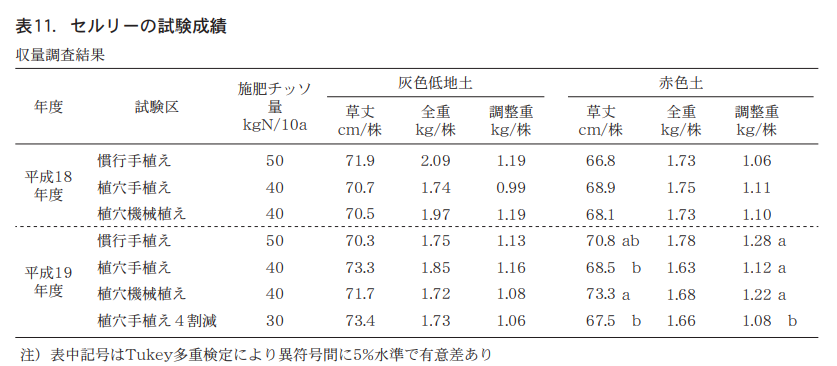

(3) Barrel-shaped large pot cultivation
This is a cultivation method in which coconut fiber is added in mortar-shaped barrels made of reinforced styrofoam as a substitute for soil and a special fertilizer (based on Hi-Control) for total basal fertilizer that does not require additional fertilizer. There are cases where 850 pots are grown in one greenhouse.
(4) Future development of root zone control cultivation
There are many examples of controlled root zone cultivation. Although the amount of fertilizer demand used on a single farm may not be large, the number of farmers adopting new cultivation methods is expected to increase due to the remarkable progress in cultivation facilities and equipment. Strawberry cultivation, which used to be done in the ground, is now going to be dominated by upland cultivation due to the aging of farmers, ease of field management, and safety and security requirements.
Root zone control cultivation of many crops is expected to increase as field management becomes more mechanized. The use of long and high control, including nitrate-form chisso, suitable for this cultivation method is expected to expand.
(12) Toward increasing demand for longs for root zone control cultivation
The most labor-intensive tasks in agriculture are planting and harvesting. In rice paddy farming, a riding fertilizer application machine that can plant seedlings and apply fertilizer at the same time has been put to practical use, and in harvesting, the development of unmanned harvesters is now being pursued in place of riding harvesters. In the future, reducing labor at the time of planting leafy greens, which are planted in large numbers, will be an important issue. The development of a granular localized fertilizer application machine for vegetables has already been attempted, and it is expected that more user-friendly machines will be developed (Table 12, Photos 6 and 7).
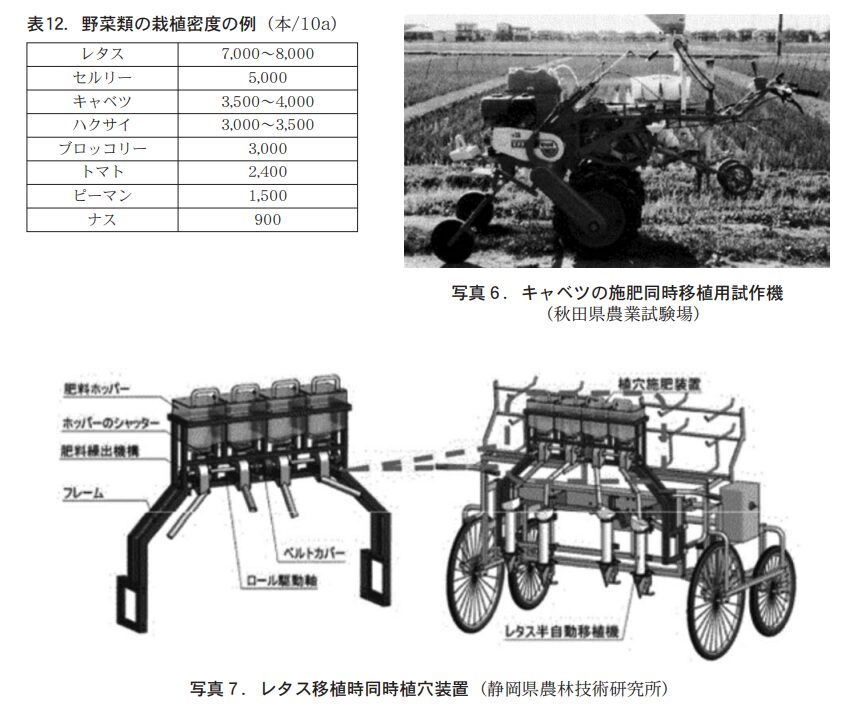
When agricultural machinery manufacturers develop this equipment, it is necessary to explain the advantages of using long, which contains nitrate-form chisso and is best suited for local application of fertilizer in planting holes and pots, and have them incorporate it into their designs. In the commercialization of "Okudake," a teapack filled with Long, we explained the characteristics of Long and completed the manufacturing process by changing the sliding plate to a brush to prevent damage to the film. We believe that tie-ups with agricultural machinery manufacturers from the initial stages of fertilizer equipment development are important for increasing demand for the Long in the planted hole fertilizer application method.
Utilization of Soil Data in Aichi Prefecture
Aichi Prefectural Agricultural Experiment Station
Katsutoshi Taki
Introduction
In this prefecture, a large amount of soil data has been accumulated through surveys, research, and administrative actions. Some are paper-based and some are digitized. The data that are used on a daily basis are the results of the national soil conservation research projects that have been carried out since the 1940s, such as the Soil Conservation Survey1) , the Soil Map2) , and the Soil Environment Survey3) . In this prefecture, approximately 450 fixed points were surveyed in the Basic Survey of Soil Environment since 1979, but the project was reorganized in 1998 and the number of survey points was reduced to one-fourth (Fig. 1).
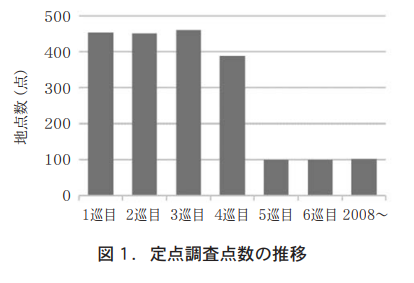
In the fixed-point survey, soil cross-sectional survey, soil analysis, and soil management have been conducted in the same field every five years. In the paddy field, a five-factor long-term continuous application test (Anjo City) and a continuous application test for soil improvement (Nisshin City) are being conducted for the 95th year, and in the field, an organic matter continuous application test is being conducted in the test site (Nagakute City). In the field, organic matter continuous application trials have been conducted in the test site (Nagakute City). The continuous trials in fields other than the five-factor long-term continuous paddy field trials have not been as long as the long-term continuous paddy field trials, as some trials had to be suspended due to the need to change locations, and others had to be terminated due to questions about the significance of continuing the trials. Other tests of continuous use of organic matter in vegetable fields were also established, and a long-term continuous use test of organic matter (including sludge) was conducted for the purpose of soil improvement in mineral soils at the Higashi Mikawa Agricultural Research Institute (Toyohashi City), which was once a designated test site by the Japanese government.
The results of these investigations and tests have been reported in numerous research reports and academic conferences, and have been widely used in the fertilizer application standards4) and organic material application standards5) of the prefecture as well as in field guidance. Here, we introduce some of the results of these studies and examples of how the research results have been used, and propose how the data should be accumulated and utilized further in the future.
2. utilization of fixed-point survey data
(1) Examples of Results Utilization
The first and most routinely utilized example is in response to inquiries from extension organizations, government agencies, and the general public. For example, "What kind of soil is the soil in the 00 region? What are its characteristics? or "What is the heavy metal content of the general agricultural land? and "What is the increase or decrease of XX content in paddy soil now compared to the past?" The aforementioned basic soil fertility conservation survey report, soil map, and basic soil environment survey report are used to answer such questions. For earlier data, we can trace back to the results of the Low Production Land Survey conducted in 1949.
(2) Publication of results
The data from the fixed-point surveys were compiled twice, in 1984 and 1996, in the booklet "New Technology in Agriculture 6, 7)" published by the National Agricultural Experiment Station. The former is positioned as an explanatory version of the basic survey results and soil maps, while the latter mainly focuses on annual trends. The latter mainly focuses on the annual trends. The research reports were compiled in 1978 and 1988 as reports 8 and 9) , and their summaries are as follows: "Decrease in soil depth and humus content," "Progression of base imbalance," "Increase in phosphoric acid content in fields," "Decrease in free iron oxide in gravel paddy fields," "Increasing trend of phosphoric acid in paddy soils and its shift to the appropriate level," "Trend of phosphoric acid in paddy soils and its shift to the appropriate level," and "Trends of soil organic matter in paddy soils. The trend of increasing phosphoric acid in paddy soils and its shift to optimization, and the fact that the disappearance of soil organic matter is closely related to the presence or absence of organic matter application.
(3) Reflected in fertilizer application standards and organic material application standards
Based on the results of the fertilizer reduction test, a fertilizer reduction standard was established and included in the fertilizer application standard. The actual situation of insufficient humus content was also the basis for conducting a continuous organic material application test. In determining the organic material application standards, sludge was determined based on the accumulation of heavy metals such as zinc content in the soil. This was determined by predicting the amount of accumulation based on the amount present in the soil based on the results of fixed-point surveys.
(4) Soil diagnostic reference values and their use in soil diagnostic programs
In this prefecture, soil diagnostic standard values are set for each crop. The appropriate base saturation is set in three categories based on the average CEC of the soil in the prefecture. The diagnostic standard values are also used in the judgment criteria of soil diagnosis conducted by JA Aichi Keizairen, and the criteria are standardized within the prefecture.
(5) Creation and utilization of land strength maps
As a result derived from the soil survey, we started to create a soil fertility map showing the characteristic values of nitrogen expression in each soil series in 1990. Subsequently, surveys were conducted in major rice paddy fields in the prefecture, and a program was developed to illustrate the results as a map, which was compiled into a manual10) in 2002. The program covers 18 districts in the prefecture, and each stroke can be color-coded and future projections can be made (Fig. 2). The program has been used as a resource for fertilizer application in various production areas, but is not being actively used at present due to the problem of management responsibility for the program.
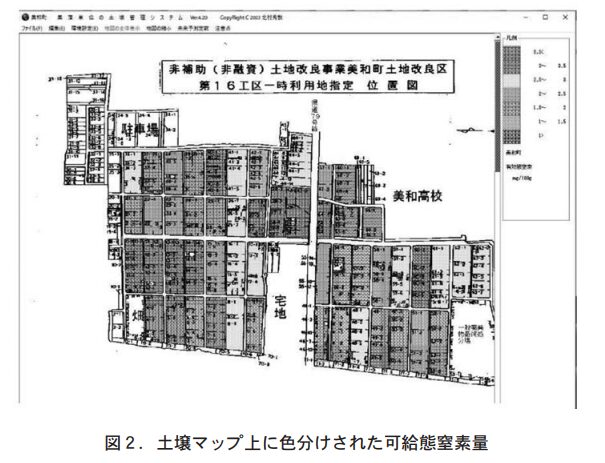
(6) Designation of land enhancement areas
In this prefecture, land fertility enhancement areas have been designated in accordance with the Land fertility Enhancement Law. Needless to say, the back data for these areas is the survey data accumulated through the Soil Conservation Project. In the past, five areas were designated, and measures to improve the physical and chemical properties of the soil have been implemented with the cooperation of the local communities.
(7) Examples of research applications
Based on the results of the area and soil carbon content of each soil series obtained from the fixed-point survey, the amount of methane generated in the prefecture was estimated11) . The number of data needed to cover the entire prefecture and to provide statistical data that reflect the actual condition of agricultural lands in the entire prefecture is about the same as that of the basic survey of the soil environment.
3. utilization of reference point surveys and other continuous use test data
(1) Utilization of data from the field (organic continuous use test)
Based on the results of a trial of continuous use of compost (cattle manure and swine manure) at the test site, the following was published as a result: "In fields where cattle manure is used continuously, it is possible to cultivate without the application of phosphate and potash fertilizers" (Taki 12), 2009). Based on the results of these studies, L-type fertilizers with lower phosphate and potash components than nitrogen components were branded and used in the field. Currently, most of the fertilizers distributed in the prefecture are L-type fertilizers. This is thought to be due to the fact that JA Aichi Keizairen, which has a BB fertilizer plant in the prefecture, and the Agricultural Experiment Station have conducted joint research, which has facilitated the understanding of the actual conditions in production areas, fertilizer reduction tests, field demonstrations, product commercialization, and dissemination.
(2) Data utilization in paddy fields (long-term continuous use paddy fields)
In this prefecture, a four-element fertilizer test and a rice straw compost application test have been conducted in the paddy fields of Anjo City (in the former Agricultural Experiment Station) since 1926. The results obtained from these paddy fields are numerous: "The yield reduction rate was large in the no-nitrogen, no-phosphate zone and small in the no-lime, no-potassium zone (Shiota et al. 13), 1980)," "The effect of yield increase was remarkable in the compost zone (Shiota et al., 1980)," "The nitrogen by origin at harvest in the 225 kg compost zone was The results of the study showed that "the nitrogen at harvest in a 225 kg compost plot was 22% fertilizer, 13% compost, and 65% soil (Shiota et al. 14), 1984)" and "the degree of reduction progress was greater when compost was applied (Ohashi et al. 15), 2015)".
Based on the analysis of the test results of phosphate-free and potash-free cultivation in paddy fields under long-term continuous use (Figures 3 and 4) and the results of complementary tests, the reduction of phosphate and potash in paddy fields was examined and it was concluded that "the soil condition at least at that point can be maintained if phosphate and potash are supplied for the amount brought up" (Ikeda 16), and 2007)
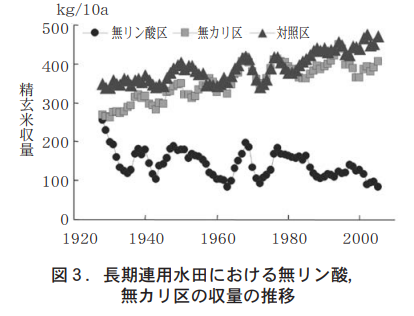
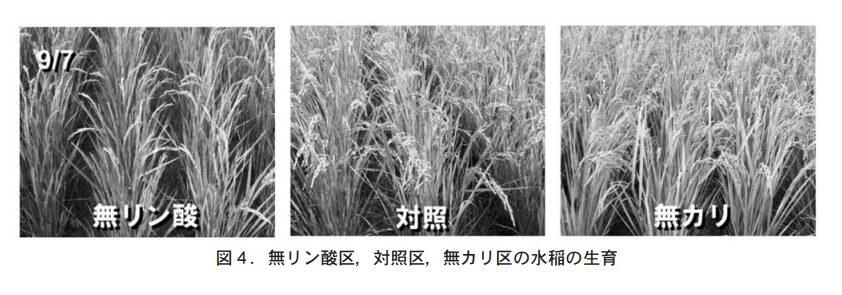
(3) Utilization for organic material application standards
The standards for the application of organic materials provide standards for the application of organic materials distributed in the prefecture, including livestock manure (Table 1).
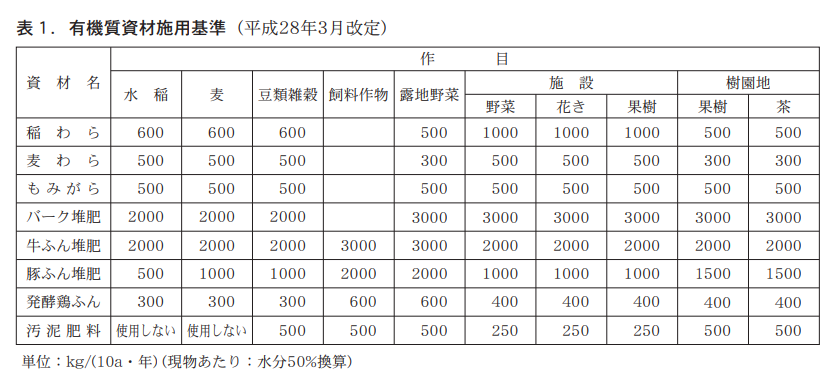
The application amounts and precautions for application reflect the results of the reference point survey and other continuous organic matter application tests. The following are shown as application effects and precautions.
In (1) paddy field, organic matter in the soil does not decrease even if organic materials such as compost are not applied for more than 80 years, as shown in Figure 5. Furthermore, the application of compost makes the soil fertile with accumulated organic matter.
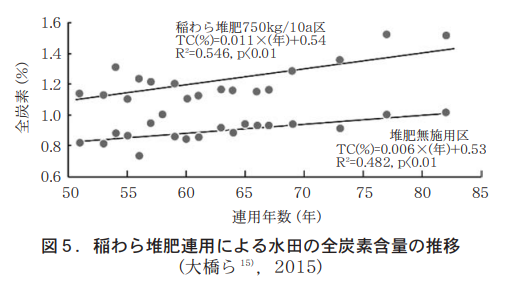
In the field, as shown in Figure 6, if organic materials are not applied, the organic matter in the soil decomposes and fertility declines. Therefore, the application of organic materials is an indispensable technology in the field.
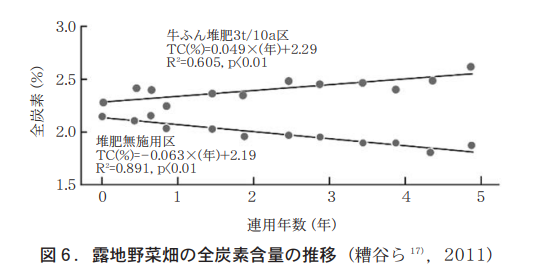
When the free iron oxide content of the crop soil is less than 1.5% in a paddy monoculture, the maximum amount of bark compost and rice straw compost should be applied is 1000 kg/10a to prevent fallout. Especially in fields with low iron content, the application of large amounts of organic materials should be avoided.
(4) In a 90-year continuous use test of rice straw compost, a clear decrease in iron content was observed in the rice straw compost area. Compost
Application of about 2000 kg/10a is likely to contribute to fallout due to iron deficiency on a scale of decades or centuries.
The standard soil diagnostic value of humus in field soil is 3-5%. In the case of an open vegetable field on yellow soil, humus content reached 51 TP3T after 10 years of continuous use of 3000 kg/(10a/year) of cattle manure and 2000 kg/(10a/year) of pig manure.
Therefore, application of less than these standard amounts is sufficient to maintain soil fertility. If more than the standard amounts are applied, the discharge of nitrate nitrogen into groundwater and rivers will be extremely high, and the discharge of dinitrogen monoxide, which has a great impact on global warming, will increase, resulting in a great burden on the environment.
4. other soil data applications
Other examples of the use of soil survey data are also presented here. The actual situation of salt damage and the process of salt removal described in the "Results of Survey on Rice Cultivation in the Former Area of Typhoon Ise Bay 18) " and "Results of Survey on Soil in the Former Area of Typhoon Ise Bay 19) ", which are the results of a survey on rice cultivation and soil in the area where seawater flowed in due to Typhoon Ise Bay that hit in September 1959, were provided as research results for on-site restoration at the time of the Great East Japan Earthquake (Fig. 7). The information was provided as research results for on-site restoration at the time of the Great East Japan Earthquake (Fig. 7).
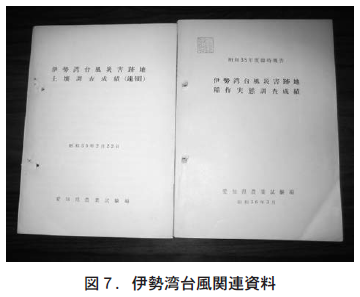
5. suggestions for future directions (towards the way data is used as required in the field)
(1) Conduct soil surveys with a primary focus on crop productivity
The information on soil cross-sectional survey could be provided to the production sites by correlating the results of soil survey with crop productivity. Therefore, it is important to correlate the results of the soil survey with the root system of the crop, and to consider the relationship with the growth and quality of the above-ground parts of the crop. For example, "the relationship between the growth of wheat and the main root zone 20) (Figure 8)," "the relationship between the root mass of wheat and the degree of soil reduction 20) (Figure 9)," and "the yield and quality of house mandarin oranges and soil diagnostic criteria 21) (Figure 10)" can be cited. In addition, we prepared a document illustrating the root system and soil survey results for institutional vegetables (Hioki et al. 22), 2009). Figure 11 shows an example (root volume of eggplant), and the data also includes the results of soil investigation and analysis (pH, EC, nitrate ion concentration, and density) for each mesh. These results may provide useful information for determining soil improvement and fertilizer application locations in the production area.

(2) Conduct soil surveys targeting production areas
As other examples of surveys, from 2005 to 2007, cultivation management surveys, soil surveys, and crop yield and nutrient absorption surveys were conducted for 14 field crops in 17 regions. The results of these surveys23) revealed the relationship between the amount of fertilizer applied and the amount absorbed by each crop, as well as the amount of nutrients in the soil, and provided useful data for fertilizer application guidance (Table 2). Thus, by surveying a certain number of points for the same crop, it is easy to obtain the cooperation of the field and to analyze the results. In addition, when the survey is conducted periodically, changes in the soil can be captured for each production area, which is useful for improving fertilizer application and providing guidance on soil management.
We believe that they are easily connected.
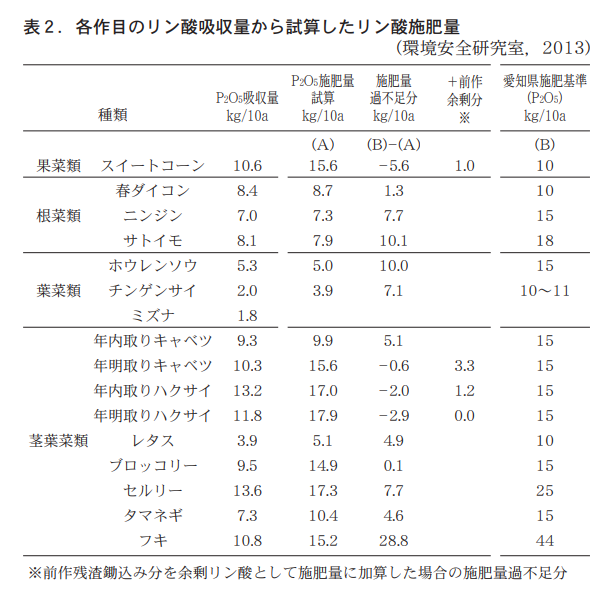
(3) Method of providing data
JA-Aichi Economic Federation is constructing a system to obtain and use various agricultural information from prefectural maps in a joint research project with the National Research Institute and Nagoya University.
In the near future, the information that can be provided will be enhanced by adding soil maps and soil data to it.
In the future, it is expected that digital information will be developed so that farm management will be possible on smartphones and tablets.
(4) Development of physicality diagnosis method
In order to provide detailed guidance for each field, it is important to diagnose the physical properties of the soil before diagnosing the soil chemistry. The first priority should be to determine whether or not conditions are in place for normal root growth, and if so, to improve these conditions. In the diagnosis of poor growth in the field, the cause is often the densification of the subsoil or poor drainage. For quality-oriented crops such as fruit trees and vegetables, it is important to fully understand the movement of moisture and water retention in the soil, but it seems that no such means have been established. Therefore, it is necessary to develop and disseminate a physical property diagnosis method that can be easily utilized in the field in the future.
6. at the end
In the agricultural field, there is a growing trend toward the development and diffusion of technologies that aim to make farming "easy" and "accessible to everyone" by making full use of ICT, AI, and other technologies. On the other hand, it is true that we can share the "joy of production" by walking through the field one by one, digging holes while listening to the voices and concerns of individual producers, checking soil hardness, drainage, and root distribution, and discussing the growth of crops. In the future, it would be desirable for all those involved in soil fertilization to review the assets of the soil fertilization field to date and discuss bringing them back to life.
References
(1) Comprehensive Report of the Basic Survey for Land Conservation. Aichi Prefecture. p.1-785 (1978)
2) Soil map of Aichi Prefecture. Aichi Prefectural Agricultural Experiment Station. p.1-33
3)土壌環境基礎調査(定点調査)成績書(尾張東部地域).
p.1−149 (1979) 〜土壌環境基礎調査(定点調査)
成績書Ⅳ(尾張西部地域).p.1−91(1997)
(4) Fertilization Standards for Agricultural Crops. Aichi Prefecture. p.1-281 (2016)
5)農作物の施肥基準.愛知県.p.22(2016)
愛知県の主要産地における野菜の養分吸収量と土壌実態.
愛知県.1−40(2013)農業の新技術No.73.p.1−91(2002)
(6) New Technology of Agriculture, No.21, Aichi Prefecture. p.1-54(1984)
(7) New Technology of Agriculture, No.68, Aichi Prefecture. p.1-54(1996)
8)長谷川徹ら.愛知県下の農耕地土壌の地力変化の実態.
愛知農総試研報A10.182−195(1978)
(9) Ikeda, A. et al. Actual condition of soil fertility of arable soils in Aichi Prefecture. Aichi Agricultural Experiment Station Research Report 20. 329-338 (1988)
10) New Technology in Agriculture "Soil Management System in Aichi Prefecture" .No.73, Aichi Prefecture. p.1-91 (2002)
11)瀧勝俊ら.愛知県下の水田土壌肥沃度の変遷にともなう,メタン,
二酸化炭素生成量の変動推定:土壌環境基礎調査の結果に基づいて.
日本土壌肥料学会講演要旨集39(1993)
12)瀧勝俊ら.家畜ふん堆肥連用ほ場におけるリン酸肥料,カリ肥料無施肥栽培.
平成21年度「関東東海北陸農業」研究成果情報(2009) .
http://www.naro.affrc.go.jp/org/narc/seika/kanto21/#10
13)塩田悠賀里ら.四要素及び堆肥の長期施用による
水田土壌の理化学性の変化と水稲の生育について.
愛知農総試研報12.52−60(1980)
14)塩田悠賀里ら.水稲の窒素吸収からみた堆肥連用の短期及び長期的評価.
愛知農総試研報16.43−51(1984)
New Technology of Agriculture, No.68, Aichi, Japan. p.1-54 (1996)
15)大橋祥範ら.稲わら堆肥89年間の連用がイネの収量.リン収支に及ぼす影響.
愛知農総試研報47.23−30(2015)
16)平成22年度関東東海北陸・土壌肥料部会秋季研究会.
土壌診断に基づく施肥節減実践の課題と展望(2010)
17)糟谷真宏ら.牛ふん堆肥または豚ぷん堆肥を連用する
黄色土野菜畑における5年間の養分動態.
愛知農総試研報43.137−149(2011)
18)昭和35年臨時報告 伊勢湾台風災害跡地稲作実態調査成績.
愛知県農業試験場.p.1−132(1961)
19) Results of Soil Survey at the Site of Typhoon Ise Bay Disaster. Aichi Prefectural Agricultural Experiment Station. p.1-31 (2010)
(20) Soil and soil development in Aichi. Aichi. p.45-46(2005)
21)瀧勝俊ら.ハウスミカン園の土壌特性と改良目標の一試案.
愛知農総試研報37.117−125(2005)
(22) Hioki, M. et al. Root system structure of institutional vegetables. Aichi Prefectural Agricultural Experiment Station. p.1-117 (2009)
23)環境安全研究室.愛知県の主要産地における野菜の養分吸収量と土壌実態.
愛知県農業総合試験場.p.1−40(2013)